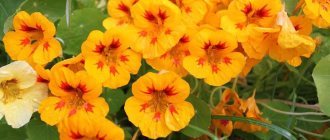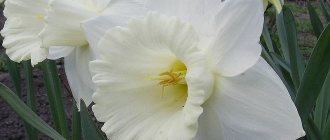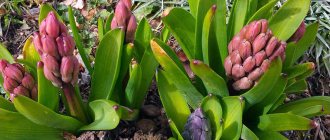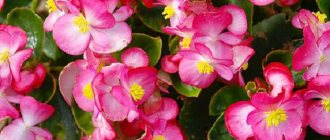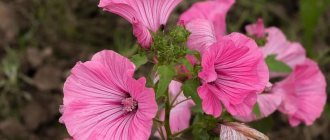A large number of flower growers in different parts of our planet have long appreciated the graceful beauty and uniqueness of the plant with the melodious name “verbena”. It is ideal for growing both in open and closed ground, so we can see the luxurious inflorescences of a delicate flower not only in personal plots and flower beds, but also on the balconies of city streets. The photo of verbena shows the period of its flowering, and we will tell you in detail how to plant the plant correctly and provide proper care in this article.
Canadian verbena Homestead Red is a low-growing variety used as an ampel and ground cover.
Verbena: what is it?
Verbena belongs to the verbena family and has about 250 varieties of seasonal and perennial plants. It grows well in any climate zone; in tropical conditions it blooms profusely almost all year round and looks like a small shrub. That is, at its core, verbena is perennial. But in our country it is most often grown as a herbaceous annual.
Plant height varies from 20-40 cm (hybrid and Canadian verbena) to 150-200 cm (Bonar verbena, hard, lemon). The width of even low-growing species often reaches 70–80 cm. Depending on the type of flower, the stems can be erect (bush varieties) or creeping (ampels).
Bonar or Buenos Aires verbena (Verbena bonariensis) is a tall plant that blooms with purple fragrant flowers.
Hybrid verbena (Verbena hybrida) is the most common species, characterized by a variety of varieties. Pictured is the Vegas Fluor Pink variety
The jagged leaves of verbena have a pleasant bright green hue. On each individual stem of the plant, 40–50 miniature carnation-like flowers are formed, which recreate a beautiful “cap”.
The color palette of inflorescences is very diverse. White, pink, peach, red, purple, blue, blue - these are not all the tones that verbena can boast of. Moreover, the flowers can be either monochromatic or combine several colors at once. For example, the hybrid verbena variety Lanai Twister Red has inflorescences with red and pink petals. And the Tuscany Burgundy Eye variety has dark burgundy flowers with a white eye in the center.
Hybrid verbena Lanai Twister Red
general characteristics
Verbena belongs to the family of simple and unpretentious herbaceous plants of the same name. These can be small shrubs, a thick flowering carpet, or even tall, straight subshrubs up to several meters tall.
Verbena flowers are always small, up to a maximum of 2.5 cm, but at the same time they are collected in dense inflorescences and brushes. The color spectrum is wide and varied: from white and yellow to pink, dark red and even blue or dark blue.
Some varieties of verbena are actively used in medicine for the treatment and prevention of digestive problems. In cooking, it is often used for flavor in the preparation of preserves and preparations. Medicinal verbena is also in demand among beekeepers and honey lovers.
Photo: domashniecvety.ru
Verbena character
Verbena is quite unpretentious. It is resistant to heat and drought. It is not afraid of slight autumn and spring frosts (down to -3°C), so it can delight with its flowering from spring to October (even longer in the southern regions).
Also, verbena does not have any special requirements for soil quality. The only condition: it must allow moisture to pass through well and prevent stagnation of water and subsequent waterlogging. Clayey, heavy soil is not suitable; it slows down root growth and causes root rot. In southern regions, perennial varieties of verbena often disappear when planted in soil that becomes soggy after heavy winter snow or spring rain. Good drainage can compensate for this problem.
Another advantage of verbena is its long flowering, which does not subside in the summer heat. And a very wide range of colors.
What plants does it go with?
Verbena can be planted alone or combined with other crops on the site. The best neighbors for the plant are:
- ornamental cereals;
- marigolds and asters;
- sage and echinacea;
- petunia and bronze fennel;
- heliotrope and cineraria.
When creating an artistic composition, it is necessary to ensure that the plants have the same requirements for conditions and care. It is recommended to use hybrid verbena to create flower beds and low borders.
Hybrid verbena is usually short in stature, so it is planted in the foreground of flower beds
Planting in garden flower beds and pots
To plant verbena in open ground, it is best to choose a well-lit place, since the plant is very heat-loving and grows well even in dry conditions.
The soil should be loose, light, it should first be enriched with humus and fertilized with a special compound (for example, humus). Ideal PH 5.8-6.2.
Be sure to avoid frost. Despite the cold resistance of adult plants, seedlings can slow down in growth when exposed to sub-zero temperatures. Verbena is usually transplanted to a permanent location in mid/late May.
Low-growing verbenas are planted at a distance of 20 cm from each other, ampelous and groundcover - at a distance of 25-30 cm. Tall species will require even more space; they are planted at intervals of 25-35 cm.
Verbena Lanai Blush White in open ground
If planting is done in indoor pots, be sure to provide drainage. To do this, place a layer of pebbles or expanded clay on the bottom of the container, only then fill the form with soil mixture.
The same verbena - Lanai Blush White - but in hanging boxes
Transplantation is carried out using the transshipment method. This means that the sprout is removed from the container along with a lump of earth. This way, the plant’s root system will remain intact, and it will quickly take root in its new location.
The finished pots are placed in the sunniest place, where it is possible to create a constant flow of fresh air for the plant.
Propagation from seeds
Verbena propagation by seeds is the most popular method actively used by gardeners. Before you begin studying the step-by-step instructions, you need to clarify general information about obtaining verbena seeds.
When does it produce seeds and what conditions are needed?
Seeds are formed in the fruits after flowering. Verbena requires minimal care, but it should not be allowed to dry out, otherwise the plant will not bloom. It is also necessary to fertilize with fertilizers during the season, but you should not get carried away with organic matter: an excess of nitrogen in the soil prevents verbena from flowering, so it is enough to apply organic fertilizers once a season.
Important! It is better to enrich the soil with phosphorus and potassium.
What they look like: description and photo
The seeds have an elongated shape and a brownish color. Externally they resemble aster seeds. They are found in fruits, which are prefabricated four-leaf nuts of a light brown or greenish hue.
This is what verbena seeds look like:
How to assemble?
The seeds should be collected when the bulk of the fruit is already dry. The signal to collect seeds is the dark brown color of the boxes.
The collection procedure will be as follows:
- cut off the inflorescence with dried nuts and place it on a spread piece of fabric or a sheet of paper;
- wait until completely dry, and to prevent possible mold, the nuts must be turned over periodically;
- remove the seeds from the fruit, pour them into a box or paper bag, and sign.
You can store the seeds in this way until the next planting season (maximum - for two years).
How and when to plant at home?
Any novice gardener, armed with auxiliary instructions, can cope with growing verbena by seed.
- Preparing the soil for sowing seeds. You can use ready-made soil for seedlings, sold at gardening stores, or make your own mixture.
To obtain a soil mixture, you need to take garden soil, sand and peat in proportions of 1:0.5:2 (it is also better to add washed sand to bagged soil from the store). It is necessary to sift wood ash into the prepared mixture (half a glass per 2 liters of mixture). Since loose, breathable and water-permeable soil is important for the successful germination of verbena, you can add ½ cup of perlite to a liter of soil mixture. To disinfect the soil, spill it with an aqueous solution of fungicide. - Sowing. Prepare a bowl for sowing by filling it with soil mixture. Seeds can also be planted in separate cups with soil, in which case there will be no need for further picking.
Compact the soil, distribute the seeds evenly over the surface without deepening them. Moisten the seeds with water from a fine spray and cover the container with sowing with glass or film. Creating greenhouse conditions will allow the seeds to retain moisture. - Waiting for shoots. To speed up seed germination, you should keep the bowl near the radiator for 2 or 3 days, then in a room with a temperature of +25 degrees. During this period, there are no special requirements for lighting, but after the emergence of seedlings, the bowl must be placed in the light, and the temperature should be from 15 to 17 degrees above zero. Shoots germinate in 10-15 days.
- Picking. As soon as the first pair of leaves emerges, the verbena needs to be transplanted, preferably into separate pots or cups. Now you will need more fertile soil than when sowing.
To prepare the mixture you will need ½ part sand and two parts each of garden soil and peat. To three liters of the resulting soil mixture you need to add a tablespoon of mineral fertilizer and half a glass of wood ash.The mixture is placed in pots, leveled, and small holes are made in the soil into which verbena is planted. There is no need to deeply bury the seedlings. The seedlings must be carefully watered and placed in the light.
- Further care. Adaptation and rooting of young verbena takes about two weeks. Afterwards, you should feed the soil with organic fertilizers for seedlings. Tall varieties at the initial stage of growth require pinching the top part of the plant.
- Planting in open ground. Verbena is not a frost-resistant plant, so it can be planted only when there is no threat of frost (in the second half of May-early June for central Russia). The seedlings are first hardened off. The permanent location in which verbena will be planted should be open and have access to sunlight.
Important! Neutral soil is required; Before planting, it is worth applying complex mineral fertilizer, and laying a thin layer of drainage in the planting holes.When planting, maintain a distance of 25-40 cm between seedlings. Afterwards, water intensively.
Watch a video on how to plant verbena seeds at home:
You can learn more about the basic rules for planting and caring for verbena here.
Basic nuances of care
With correct planting of verbena and high-quality care, the plant will bloom profusely from the end of May until the end of October inclusive; the inflorescences are distinguished by their attractiveness; you can appreciate their tenderness and beauty from numerous photos of flowers.
Regardless of the growing conditions for verbena (outdoor/indoor), you need to provide the plant with ideal conditions:
- the temperature should vary in the range of 22–28 degrees; if it increases significantly, experienced gardeners advise covering the verbena with a light cloth or temporarily moving it to the shade;
- the same applies to lighting; scorching sun rays can lead to rapid drying of the soil and leaves;
- complex fertilizer is applied once every 2–3 weeks throughout the entire flowering period;
- water the verbena after the top layer of soil has dried; it is not recommended to spray the leaves and top;
- after watering, loosen the soil - this improves root aeration;
- to prolong the flowering period, faded inflorescences are torn off;
- If necessary, you need to trim overgrown shoots, this will help to form an attractive flower head.
Verbena in a composition with petunia in a hanging pot
Propagation by cuttings
Not all gardeners know how to grow verbena from small shoots. To do this, you need to dig up the mother plant for wintering in October. The room temperature must be maintained within 10 °C. At the end of February or beginning of March, the upper part of the shoot with leaves is cut off. Its length should be about 10 cm. There should be 5-6 leaves left on the branch.
At least 1 cm is left between the lower node and the beginning of the cutting. The tip of the shoot is treated with root or other growth stimulant. After this, it is planted in a mixture of peat and sand (the components are mixed in a 1:1 ratio).
Important! The cutting is deepened to the first pair of leaves.
It is better to cover the container with verbena with a glass jar or polyethylene to create a greenhouse effect. Rooting takes about 30 days, after which the seedling can be planted in the garden plot.
Diseases and pests of verbena
The diseases to which verbena is most susceptible are:
- powdery mildew - a white powdery coating forms on the surface of the leaves and flowers, the lower leaves turn yellow and sag, gradually the entire bush turns yellow and dies without treatment;
- gray rot - spots appear on the leaves, buds and flowers rot, infected tissues become covered with a gray dusty coating;
- root rot - the plant turns yellow and withers, the roots become dark brown.
Powdery mildew on verbena
All these diseases are fungal in origin and occur due to improper watering or infection. Fungicides are used for treatment.
Of the pests that attack verbena:
- Thrips - pierce and suck out plant cells, as a result of which silvery-gray “movements” and spots appear on the surface of the leaves. When the level of infection is high, the leaves dry out.
- Spider mite - pierces leaf tissue, leaving small yellow dots on it. Lives and feeds on the underside of leaves. When the population is high, it forms a web.
- Aphids - feed on plant sap, piercing the tissue. This slows growth and can cause leaf death.
To destroy aphids and thrips, insecticides are used; for spider mites, an acaricide is needed.
Important!
Healthy, vigorous plants are less susceptible to pests. Therefore, when growing verbena, the main thing is to pay attention to proper agricultural technology.
How to Preserve Verbena in Winter
To ensure proper wintering, garden verbena is cut to 1/3 at the end of autumn and then dug up so that the roots of the plant are completely covered with soil. Such cuttings are best preserved in dark cellars.
House flowers are moved to a warmer, brighter place before the first frost arrives. The temperature in the room should not exceed 15°C, otherwise an active growing season will begin.
The stems are shortened by half, and the resulting inflorescences are periodically removed until spring. At the end of February, the remaining trunk is shortened as much as possible and transplanted into a new pot, with a complete replacement of the soil. This way you can preserve last year’s verbena, which will still bloom in the new season (that is, make it a perennial even in our climate). However, most often it is used as a mother plant for cutting cuttings and growing new young bushes.
We invite you to watch a video about cuttings from an overwintered verbena mother plant:
If you strictly follow all these recommendations, then next season the verbena will grow more actively and new flowers will quickly grow on it!
Common types
Verbena is cultivated not only as an ornamental plant, but also as a medicinal plant. Therefore, many varieties have been bred that differ in the size and color of the flowers.
Ampel verbena - growing in a pot, planting and care
Hybrid species combine a large number of different verbenas. They all have a strong odor and colors range from white to dark purple. The inflorescences have a spherical, spikelet or umbrella shape. Sometimes hybrid varieties are called a fad.
Verbena erecta is widespread in the United States. It has gray leaves, flowers cover the stem in the form of a spikelet. The hard variety got its name because of its unusual leaves. They have pointed tips and are particularly durable. The variety has lilac inflorescences, and the plant itself is low-growing.
Note! All varieties are conventionally divided into three groups. The first reaches a height of 50 cm, bush ones rarely exceed 30-40 cm, compact ones grow no more than 20 cm.
Ampel varieties
Verbena with hanging stems is grown in pots or flowerpots. They grow well, bloom beautifully and can brighten up any outdoor space.
Among the hanging varieties, Imagination is distinguished. It is distinguished by small stems, the length of which does not exceed half a meter. The inflorescences are lilac-violet, spherical.
Important! The Imagine variety grows quickly and is often used as a ground cover crop.
Tiara Red Impre is distinguished by the rich red color of its flowers. They stand out brightly against the background of green foliage. An unpretentious variety that has a high level of resistance to environmental conditions.
The Peach and Cream variety attracts attention with peach tones
Verbena in a flowerpot will decorate any balcony, for example Verbena Ideal. Lenai Candy Kay has a berry aroma and large red star-shaped flowers.

